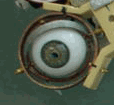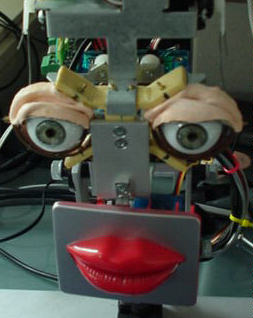Inkha Eye Hardware
mechanism
the eye mechanism with five degrees of freedom was purchased as a complete unit from androidworld.com in texas, usa
the eye mechanism contains two supercircuits
pc-53-xp cameras
these cameras output in ntsc format which is converted to usb input via two
trust usb audio video editors from habitek
movement
eyelid and eye movement was measured on a
human so that the limits of mechanical movement of the assembly could be compared with
human movement and so that control system limits could be set
results were as follows:
| eyelid position | angle (degrees) |
| at rest | 30 |
| fully open | 50 |
| fully closed | -20 |
| eye movement | angle (degrees) |
| pitch | ± 35 |
| roll | ± 5 |
| yaw | ± 50 |
blinking
blinking in humans was observed
rules were very complex to obtain as observations showed that humans blink
rate depends upon personality, tiredness and the immediate situation, e.g. humans blink
more when conversing
furthermore blinks are not regular - double blinks and missed blinks can
often be observed
irises
during human conversation the eyes are a
central element of communication
it was important that inkha had realistic eyes in order to encourage
interaction
the eye assembly was supplied with painted on irises

original iris
the ocular prosthetics department at moorfields eye hospital in london was approached for advice and they recommended hand painted realistic cornea units from orbital prosthetics
the prosthetic irises were delivered with
plastic stalks attached
king’s college workshop used a lathe to cut a 3mm hole through the
centre of the irises to remove the stalks and provide a clear window for the cameras
on fitting to the eyes it was found that much of the field of view of the
cameras was obscured
after several attempts at widening the holes with a hand held reamer they
were taken back to the workshop to be drilled out to 45 degrees and polished
this gives no obstruction to the cameras and a reasonable aesthetic

iris with 3mm hole

final 45 degree iris
eyelids
in order to block the cameras when the
eyelids are lowered and in order to improve the aesthetics of the face various designs
were made for eyelids
experiments were made with rubber cut from balloons but these were
unsuccessful
neal scanlan at neal scanlan animatronics studios in london was approached
for advice and he gave full instructions on how to make eyelids from layers of vulcanised
latex rubber built up in a mould
eyelids were constructed and attached to Inkha in October 2002

inkha with vulcanised latex rubber eyelids